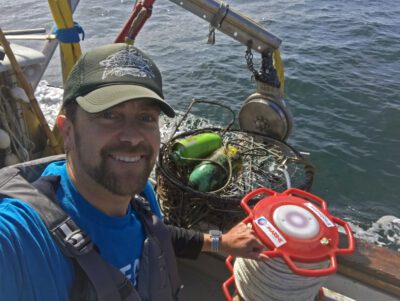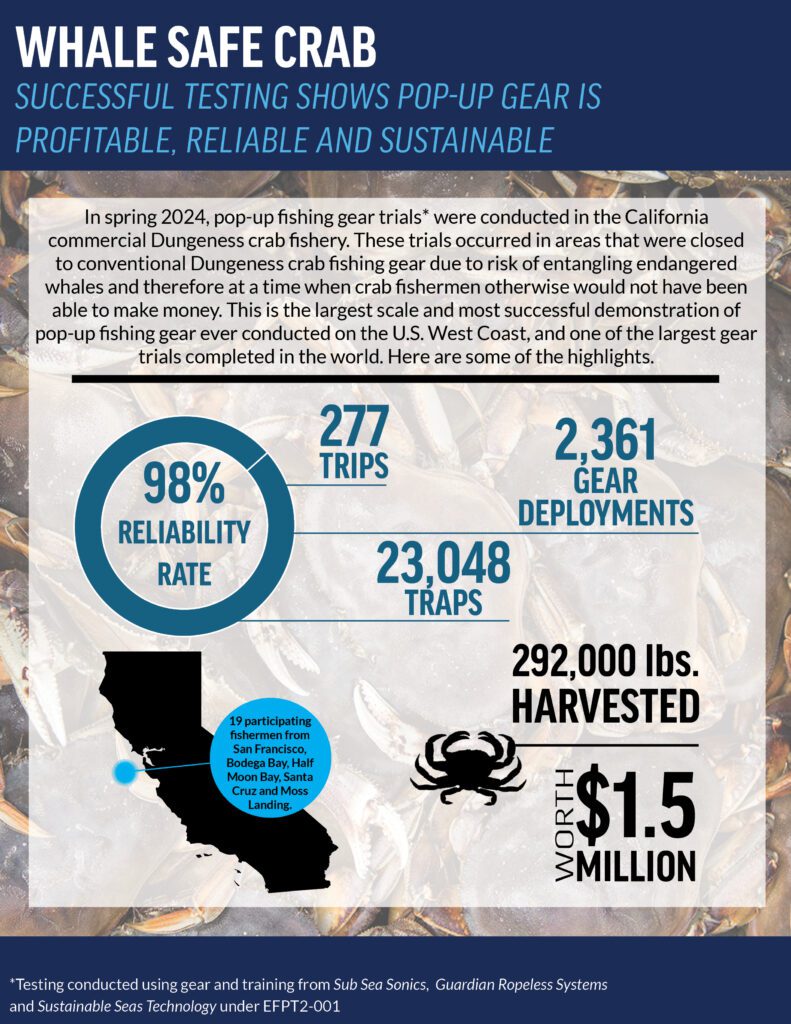Solutions
Using Innovative, Pop-up Fishing Gear to Avoid Entanglements While Continuing to Fish
Pop-up fishing gear is a way to prevent whale entanglements while providing additional fishing opportunities, particularly at times when areas are closed to conventional crab traps — gear that uses vertical lines attaching the trap on the seafloor to a buoy at the surface. Pop-up gear stores the rope and buoy with the trap on the seafloor until a release mechanism is triggered that allows a flotation device to surface so fishermen can retrieve the catch. Hence, there is no vertical rope in the water except close to when the trap is being retrieved. Release mechanisms can be set to release at a certain time (“timed release”) or upon receiving an acoustic signal from a fishing vessel (“on-demand release”). Pop-up gear systems are supported by a tablet/cell-based app available to the public via iOS and Android operating systems which enables fishermen to retrieve their gear with a quick click or swipe of the app. Because there is no surface buoy to alert fishery managers or other fishermen where these traps are located, a virtual gear marking system accessed through apps, websites, and databases is used to record the trap locations allowing the locations of all pop-up gear to be viewed at any time.
Since 2018, Oceana has worked with California Dungeness crab fishermen, gear manufacturers, fishery managers, and enforcement officers to conduct initial tests of pop-up fishing technologies. Throughout these trials, fishermen were able to successfully deploy and retrieve crab traps with multiple pop-up systems with an overall success rate of 95%. In 2021, Oceana partnered with pop-up gear manufacturer Sub Sea Sonics to conduct trials of reliability of timed-release pop-up gear in the rock crab and Dungeness crab fisheries in Monterey Bay, demonstrating high reliability and functionality. Click here to read the summary report. Oceana’s report, Pathway to Pop-up Fishing Gear outlines an iterative approach to the testing, authorization, and commercial use of pop-up gear in the California Dungeness crab fishery and can be accessed here.
In 2023 the California Fish and Game Commission approved the first Experimental Fishing Permits for pop-up gear to allow fishermen to commercially test this whale-safe fishing method. Approved alternative gear can be used in spring months (beginning April 1) to allow continued fishing even when whales are in the fishing grounds. This provides incentives for fishermen to use the gear and allows for continued crab fishing opportunities during the season while avoiding entanglements.

In spring 2024, 19 commercial California Dungeness crab fishermen participated in the largest and most successful pop-up gear trial of its kind on the U.S. West Coast using Sub Sea Sonics/Guardian Ropeless pop-up gear. They brought in 229,000 pounds of crab worth $1.5M, with high reliability and minimal gear loss. At the same time the waters off central California were closed to conventional crab gear to prevent whale entanglements.

Time and Area Closures
When whales and sea turtles are present in larger numbers, fishery managers can temporarily close areas to conventional crab fishing for a specific length of time to decrease the risk of entanglement. These areas are then reopened to fishing once whales and sea turtles leave the area. These time and area closures can be informed by a number of approaches.
Regular surveys of fishing areas using boats or airplanes can assess the overlap of fishing gear and wildlife. Dungeness crab gear visible from the air can be plotted using GPS to highlight places and depths where pots are most abundant. In 2016, Oceana partnered with NOAA scientists and LightHawk—a nonprofit organization that coordinates flights to collect data in support of conservation efforts—to conduct the first aerial survey to quantify number and locations of crab pots. The California Department of Fish and Wildlife now conducts its own aerial surveys.
In addition, data from whale watching operations that maintain daily whale sightings can be used as an indicator for when whales arrive and depart, and systematic surveys by boats can be used to quantify the locations of both traps and wildlife. Movements of whales and sea turtles can also be tracked using tags attached to individual animals. New technologies enable real-time, automated data using electronic monitoring. For example, Global Fishing Watch is an online platform that could be used to automatically identify the location of fishing traps by tracking the movements of fishing vessels. The combination of whale and sea turtle sightings, oceanographic and forage fish data, and fishing effort can then be overlaid to determine specific times and areas of elevated entanglement risk.




